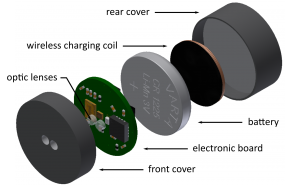 My current efforts focus on integrating the DCS blood flow measure with conventional fNIRS; improving depth sensitivity and spatial resolution with time-domain techniques and developing wireless and wearable low cost sensors. I am particularly interested in measuring and modeling the neuro-metabolic-vascular relationship during brain development, and its alteration by disease.
My current efforts focus on integrating the DCS blood flow measure with conventional fNIRS; improving depth sensitivity and spatial resolution with time-domain techniques and developing wireless and wearable low cost sensors. I am particularly interested in measuring and modeling the neuro-metabolic-vascular relationship during brain development, and its alteration by disease.
Time-gated diffuse correlation spectroscopy
 In collaboration with Lincoln Lab and Boston University we are developing a novel near-infrared spectroscopy system based on time-gated diffuse correlation spectroscopy (fDCS). The gated fDCS system will allow to use sources and detectors mounted close to each other (<1cm) in wearable optodes. This approach will provide fundamental improvements on depth and spatial sensitivity and will add blood flow functional measures to the conventional hemoglobin changes. The realization of time-gated fDCS optodes will result in a transformative impact in human neuroscience.
In collaboration with Lincoln Lab and Boston University we are developing a novel near-infrared spectroscopy system based on time-gated diffuse correlation spectroscopy (fDCS). The gated fDCS system will allow to use sources and detectors mounted close to each other (<1cm) in wearable optodes. This approach will provide fundamental improvements on depth and spatial sensitivity and will add blood flow functional measures to the conventional hemoglobin changes. The realization of time-gated fDCS optodes will result in a transformative impact in human neuroscience.
Next generation of fNIRS and fDCS devices for Brain Computer Interface
We are investigating the advantages of fDCS on cognitive neuroscience applications. In parallel we are developing strategies to reduce the cost of the technology.
